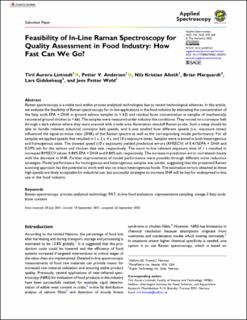| dc.contributor.author | Lintvedt, Tiril Aurora | |
| dc.contributor.author | Andersen, Petter Vejle | |
| dc.contributor.author | Afseth, Nils Kristian | |
| dc.contributor.author | Marquardt, Brian | |
| dc.contributor.author | Gidskehaug, Lars | |
| dc.contributor.author | Wold, Jens Petter | |
| dc.date.accessioned | 2022-06-01T08:02:49Z | |
| dc.date.available | 2022-06-01T08:02:49Z | |
| dc.date.created | 2022-05-25T21:19:03Z | |
| dc.date.issued | 2022 | |
| dc.identifier.citation | Applied Spectroscopy. 2022, 76 (5), 559-568. | |
| dc.identifier.issn | 0003-7028 | |
| dc.identifier.uri | https://hdl.handle.net/11250/2997152 | |
| dc.description.abstract | Raman spectroscopy is a viable tool within process analytical technologies due to recent technological advances. In this article, we evaluate the feasibility of Raman spectroscopy for in-line applications in the food industry by estimating the concentration of the fatty acids EPA + DHA in ground salmon samples (n = 63) and residual bone concentration in samples of mechanically recovered ground chicken (n = 66). The samples were measured under industry like conditions: They moved on a conveyor belt through a dark cabinet where they were scanned with a wide area illumination standoff Raman probe. Such a setup should be able to handle relevant industrial conveyor belt speeds, and it was studied how different speeds (i.e., exposure times) influenced the signal-to-noise ratio (SNR) of the Raman spectra as well as the corresponding model performance. For all samples we applied speeds that resulted in 1 s, 2 s, 4 s, and 10 s exposure times. Samples were scanned in both heterogenous and homogenous state. The slowest speed (10 s exposure) yielded prediction errors (RMSECV) of 0.41%EPA + DHA and 0.59% ash for the salmon and chicken data sets, respectively. The more in-line relevant exposure time of 1 s resulted in increased RMSECV values, 0.84% EPA + DHA and 0.84% ash, respectively. The increase in prediction error correlated closely with the decrease in SNR. Further improvements of model performance were possible through different noise reduction strategies. Model performance for homogenous and heterogenous samples was similar, suggesting that the presented Raman scanning approach has the potential to work well also on intact heterogenous foods. The estimation errors obtained at these high speeds are likely acceptable for industrial use, but successful strategies to increase SNR will be key for widespread in-line use in the food industry. | |
| dc.description.abstract | Feasibility of In-Line Raman Spectroscopy for Quality Assessment in Food Industry: How Fast Can We Go? | |
| dc.language.iso | eng | |
| dc.title | Feasibility of In-Line Raman Spectroscopy for Quality Assessment in Food Industry: How Fast Can We Go? | |
| dc.title.alternative | Feasibility of In-Line Raman Spectroscopy for Quality Assessment in Food Industry: How Fast Can We Go? | |
| dc.type | Peer reviewed | |
| dc.type | Journal article | |
| dc.description.version | publishedVersion | |
| dc.source.pagenumber | 559-568 | |
| dc.source.volume | 76 | |
| dc.source.journal | Applied Spectroscopy | |
| dc.source.issue | 5 | |
| dc.identifier.doi | 10.1177/00037028211056931 | |
| dc.identifier.cristin | 2027520 | |
| dc.relation.project | Norges forskningsråd: 309259 | |
| cristin.ispublished | true | |
| cristin.fulltext | original | |
| cristin.qualitycode | 1 | |
